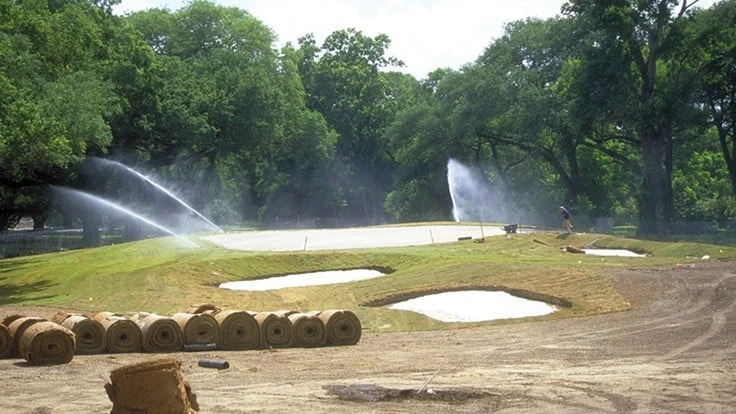As the pandemic gripped the global golf business earlier this spring, the leadership of the Golf Course Builders Association of America braced for a major hit as many assumed that mass cancellations of projects were likely. But a member survey and feedback from America’s leading golf course construction companies paints a more optimistic picture of the renovation and remodeling market in a post-coronavirus market.
About 70 percent of GCBAA’s members reported cancelled projects of some kind but nearly 30 percent said they’d seen no big impact on schedules thus far. Overall, many were optimistic about recovery. “I think what surprised me the most is, compared to the 2009 recession in golf, our members are more optimistic about the outlook post-COVID-19,” GCBAA executive director Justin Apel said.
When asked about the short-term, 38 percent of GCBAA members said they expect things to stay the same or even increase after COVID-19 and 22 percent indicated they are unsure, but optimistic, that everything will return to normal. Only 9 percent said their future projects have been canceled and they are worried about course closures, while another 9 percent reported current projects are being postponed and they weren’t seeing new projects.
“The majority expect business to stay about the same and many think it may increase again once it is safer for the employees to be on sites,” Apel said. “My sense is facilities know these projects were deferred maintenance projects that could not wait.”
 GCBAA executive director Justin Apel is seeing encouraging signs from the association's members despite the challenges created by COVID-19.
GCBAA executive director Justin Apel is seeing encouraging signs from the association's members despite the challenges created by COVID-19.
Also good news was that many GCBAA members had full schedules and even had projects on waiting lists. That should make recovery much more attainable than the downturn a decade ago. “The recession in 2009 hit harder because the business had already been slowing for years beforehand and few clubs had the capital reserves they needed,” Apel said.
Like most businesses, builders quickly adjusted work styles even in the travel-centric construction business. About a third encouraged employees to work from home. Other precautions, like disinfecting equipment, wearing preventative masks and handwashing, are routine practices.
And labor allocation has changed too, according to Apel. “What has been most interesting to me is many of the members created ‘crews’ of employees that now travel together and remain on various job sites rather than sending employees from job site to job site depending on the construction schedule, weather delays, etc,” Apel says. “Now builders keep these teams together on the specific job site until completion. The teams work together as a family, monitoring their health, maintaining separation on the job site and monitoring themselves for any signs or symptoms making it easier to respond accordingly.”
What is the association telling clubs, superintendents and others weighing whether to proceed with projects or delay? “Most current projects were still intended to catch up with deferred maintenance plans from years ago,” Apel says. “Good facilities wisely built budgets and master plans to cover the cost of the project and worked with members of the ASGCA, GCSAA, and GCBAA to maximize their investment into the renovation project. The smart thing is to stay the course, do the work your facility needs and emerge from this downturn stronger than they went in.”
Anecdotally it’s clear that many facilities that experienced temporary shutdowns powered ahead with “COVID renovation projects” that were more easily accomplished on an empty course even with a skeleton crew. “Timing is everything when you’re trying to minimize disruption to play so our folks were able to jump in and work with superintendents and a few workers to accomplish a lot in a short time,” Apel says.
Apel is also justifiably proud of the way the golf industry has responded to the challenge of ensuring player safety and making the case to authorities that courses be allowed to be open. “In the beginning we saw a number of states prematurely shut down golf and through an educational campaign and the allied golf associations nationally and locally were able to educate governors and allow golf to continue to be a safe recreational option,” he says.
What’s the future hold for the construction market? “I’m really optimistic about the future of our game as long as we can evolve along with the changes society experiences,” Apel says. “There will also be a demand for quality construction work as long as golf courses continue to evolve … and that seems like it will continue for the foreseeable future.”
Report written by Pat Jones.

 GCBAA executive director Justin Apel is seeing encouraging signs from the association's members despite the challenges created by COVID-19.
GCBAA executive director Justin Apel is seeing encouraging signs from the association's members despite the challenges created by COVID-19. 




